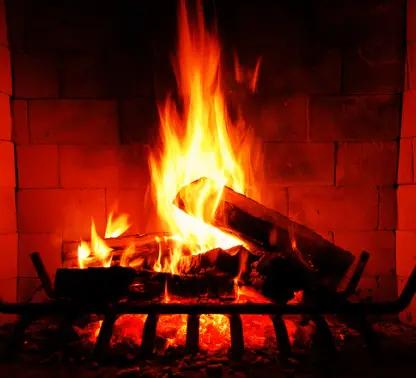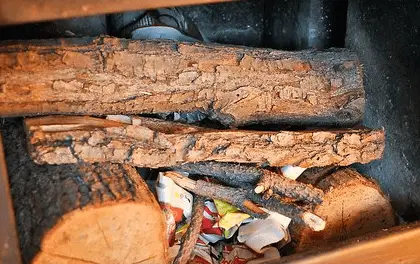Fireplaces help keep us warm and cozy in the cold winters and turn cut the monthly energy bills because you do not have to turn on the heater more often. They also improve the value of our homes and this pays off when reselling the property.

For those of us who have fireplaces at home, you know the joy that comes with having one. There is nothing as cozy as unwinding in a couch in front of a blazing hearth.
But did you know that some people have never had this great experience just because they started their fireplace the wrong way? You heard me right; only a few people know how to do it, despite the majority of people owning fireplaces in their houses.
Starting a fireplace the wrong way only leaves you with an uncomfortable living room due to the chocking smokes. What was meant to be a nice quiet evening at the fireplace now becomes a smoke engulfed experience.
If the above discussion describes you, do not panic; I am going to tell you where you have been going wrong and what you need to start a great fire the proper way.
Before you get started here are the things you first need to do to make a good fireplace;
1. Make a list of the items that you need
Just like any other project that needs adequate preparation, you will also need to prepare with effectively if at all you are going to end up with a cozy fireplace this evening.
Doing so will save you the hassles of going to your garage or store to get some more wood logs that you would have gathered earlier during the day. Besides, you do not want to step out in the cold only when you just started getting warm from the fire.
Among the things you need to make a great fireplace includes; old newspaper pages (not magazines), wood logs, matchbox or lighting gun, and kindling. I insisted on old newspapers in place of magazines because magazine pages have a gloss that makes lighting difficult.
The worst-case scenario is where you are left keeling over toxic smokes produced by the gloss on magazine pages. Ensure to gather dry wood logs so that you do not end up with a smoke-filled fireplace.
2. Clean the fireplace
Burning wood produce heaps of ashes and this is why cleaning your fireplace is important before you start your fire. Remove any debris and ash that may be blocking your hearth.
Too much ash only ends up making your lighting step very difficult, and at the same time reducing the intensity of the heat produced. As a result of incomplete burning, you may also find some wood chippings.
Starting a fireplace with these still in the hearth will make the process difficult and your fire may never light up. Use a spade to scoop the ashes and debris then empty the contents into a bucket. You can use the ashes and debris to complement your backyard composite.
3. Open the damper
The damper is the part that separates the flue and the hearth. It serves the primary purpose of controlling the amount of airflow and consequently the size of flame in your fireplace. When it is fully open, airflow is at maximum and this leads to lots of burning.
The opposite leads to small fire flames. When the fireplace is burning, the damper should be closed to prevent cold air from finding its way into your warm living space.
But before starting your fireplace, you need to ensure the damper is open, otherwise the smoke will find its way back into the house instead of escaping the house through the flue.
You are advised to open the damper for between 15 and 20 minutes before starting a fire. This will prevent draft reverse.
4. Prime the flue
On a cold night in winter, the air from outside is cooler than the one inside the house. And because cold air is denser than warm air, it starts moving to the hearth through the flue, creating a phenomenon known as the draft reverse. In this case, starting or maintaining a fire is difficult, if not impossible.
Allowing airflow some minutes before staring at a fireplace allows the cold air from outside to come to room temperature. Priming the flue simply means testing if the flue still has the draft reverse.
To do this, light some rolled pages of old newspaper and hold it inside the flue for some time. This also helps speed up the process of bringing the air in the flue to room temperature for better lighting.
5. Make an ash bed
An ash bed makes the lighting easier while also acting as an insulator for maximum heat retention in the hearth. On the other hand, ensure not to leave too much ash since this would work the other round.
After you have spread the ashes all over the hearth, place the wrought iron grate on top. It helps allow circulation below and between the wood logs.
How to Start a fireplace -The Process

When making a fire in a wood fireplace, there are two ways to do it namely; the ‘log cabin’ and the ‘top-down’ method.
Each of these methods is just fine but works a little differently depending on your needs.
’Log-cabin’ method
- Place tow small sticks parallel to each other on the grate. The sticks should be 6 inches apart and they should have no barks. This helps speed up the lighting since you do not want your fire to go out even before it finishes lighting.
- Crumple some pages of old newspapers between the two small logs.
- Place your kindling between the small logs one by one.
- Place two medium-sized wood logs perpendicular to the smallest logs you placed at the beginning of this process.
- Repeat this arrangement with the other larger wood logs to add more layers on top. Remember not to exceed the height of your wood arrangement more than half the height of your fireplace. Doing so would only leave you with a crowded fireplace that may never light up, and even if it does, it will produce so much smoke.
- Using a match or a lightning gun, light up your kindling, sit back, and enjoy your fireplace.
‘Top-down’ method
- This method is simply the opposite of the common log cabin method since it starts with the largest logs at the bottom and finishes with the kindling at the top.
- Place two of the largest logs in parallel and about 16 inches apart.
- Place two of the medium-sized wood logs perpendicular to the ones below.
- Repeat this arrangement until you remain with the smallest wood logs on top. (each layer should be perpendicular to one on top of it)
- Place your kindling on top of the smallest wood logs
- Light up the kindling use a match, sit back, and enjoy your fireplace.
As you may have realized, the above discussion only involves the wood fireplace. For a fireplace that relies on gas or coal for burning, starting the fire should be bliss. You should have wrought iron andirons to turn the wood logs from time to time. This helps increase circulation between the logs to keep the fire burning for as long as you would want.